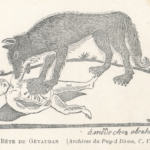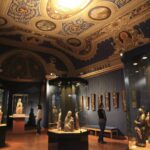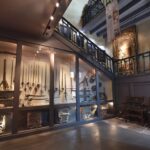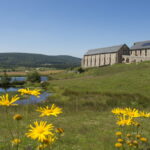It was in Gévaudan that this wild beast had established his everyday encampment…Nevertheless, this monster repeatedly made incursions into Auvergne, especially in the region of Saint-Flour, where it devoured numerous victims. And to save themselves, the parishes of Auvergne joined forces
with those of the Gévaudan…-François Fabre
The isolated highlands of pre-Revolution Gévaudan and Auvergne were full of wolves. Encounters with these predators were commonplace, a source of both annoyance and fear. Still, everyone knew that wolves were — to use the much-repeated Donald Rumsfeld phrase — “known knowns”, not “unknown unknowns”. Like any other animal that threatened public safety, they could be tracked and hunted down. Not so with the Beast of Gévaudan.
Between 1764 and 1767, this mysterious but very real monster or monsters killed or attacked scores of people, creating what the Paris Illustrated Review called a “scene of ravages without precedent”. The Beast’s reign of terror was ultimately put to an end in June 1767, but by that time it had already acquired an everlasting reputation as a sinister supernatural force.

Over the ages, sensational news stories changed truth to legend. The Beast, escaping the clutches of museum curators, became more of a phantom than a flesh-and-blood reality. In order to capture some sense of the spirit of the times and feel — as the inhabitants of old Auvergne did — an awe for a wild, seemingly primeval force, one must get up close and personal with the history and geography of the areas throughout which the Beast carried out its attacks. In Auvergne, Beast of Gévaudan territory — if we can call it that — included a number of places, the most interesting of which are: Saint-Flour and Saugues.

des Pays de Saint-Flour
Saint-Flour
Early reports indicate that the Beast surfaced in rural areas near Saint-Flour, the principal cathedral town of Cantal. Situated atop a basaltic hill on the northern edge of the Margeride mountains, the city has long been described as a Auvergne’s gateway to Gévaudan territory. Saint-Flour boasts two fascinating cultural history museums: the Musée de la Haute Auvergne and the Musée d’art et d’histoire Alfred-Douët. Both feature detailed exhibits that shed light on the mores, popular beliefs, and superstitions of early Auvergne. The Musée de la Haute Auvergne, for instance, has various artefacts on display, including carved wooden staffs and rings allegedly used for magical rituals. Similarly, the Musée d’art et d’histoire Alfred-Douët also has a collection of objects used in sorcery, such as wax effigies and pins.

des Pays de Saint-Flour

des Pays de Saint-Flour
Another attraction located further afield from Saint-Flour is the Écomusée de Margeride — an open-air, living history museum that allows visitors to immerse themselves in the cultural and social traditions of early Margeride-Gévaudan society. Spread across several towns, including Ruynes-en-Margeride and Loubaresse, the museum is comprised of a farmstead plus other restored and furnished vernacular buildings.
Saugues
No visit to Gévaudan territory would be complete without a visit to Saugues, a medieval town in which the memory of the wolf attacks are still fresh. Saugues has fully embraced the Beast’s cultural significance, adapting the legend into eye-catching works of art. One of these artworks — a totem-like wooden sculpture (crafted by local artist Jean-Pierre Coniasse) — has watched over the town for over twenty-five years.
The second artistic memorial to the Beast in Saugues is the Musée Fantastique de la Bête du Gévaudan, a museum that uses handmade mannequins and other paraphernalia to explore the real and mythic dimensions of the Gévaudan tale. It features about twenty-two dioramas, some of which will certainly interest Ufologists and other modern folklore collectors.


Those who want to journey deep into the heart of the Gévaudan countryside should head to Le Domaine du Sauvage. This 750-hectare (over 1,850 acres) property, which is situated twenty-five minutes south of Saugues amidst forests and moorlands, includes a fortress-like auberge. Owned by the department of Haute-Loire, the inn is managed by a collective of farmers and features dozens of guest rooms, an on-site restaurant, and a shop specialising in local products.

To receive more information on “Occult Auvergne” — sign up for our newsletter below!










